Abstract
This report illustrates the development of the final year project of a web-based Management System developed for KS Secondary School. The challenges associated with the current dilapidated data administration in the school were discussed. The benefits that would definitively come with the implementation of the project like reliability and authenticity of information were also described in this report.
This report focused on the improvements regarding data information communication, easy tracking different school activities by both parents and other school stakeholders, and the stepwise implementation of this data management system. The implementation process was scheduled to commence with infrastructural development of the web-based system and record of all school data into the system for upload.
The report further discusses business analysis conducted by the team of system developers and other data management models. The alternatives to the web-based data management system were analyzed on their suitability, which formed the basis of the management’s decision in collaboration with the team of experts. The report explains the internal strengths and weaknesses and the external opportunities and threats that KS school faces as far as the implementation of this project is envisioned.
The implementation process was scheduled to commence with the infrastructural development of the web-based system and upload all school data into the system. The factors of success include fast-tracking of performance by parents and the creation of an interactive platform. The report further discusses the methodologies that can be used in system development, which the team of experts researched on, and the suitability of structured method that was used. The evaluation results indicate how the web-based management program will operate with a mobile App.
Introduction
Background Information
Being at the starting point or stage in school management information systems, school computerization has been the basic subject of many schools’ management. School administrators are making use of information systems in the daily management of student and staff affairs. The uptake of the use of information systems is associated with enhancing effectiveness at the schools by processing information, improving managerial efficiency and effectiveness by satisfying the need for up-to-date information, and directing strategies.
The school information management system is supposed to support curriculum activities by processing information and delivering it in a usable form. The school information management systems are, therefore, designed to ostensibly match the management task, structure, instructional processes as well as any special needs that the school may require.
It can also be deemed contributing to the development of more efficient and effective programs while changing the learning environment by helping teachers share and exchange their experiences in an organized, systematic manner. The system can also help in the determination of the students’ needs. Additionally, it offers support in the managerial roles of school administrators and other staff in accomplishing their tasks and duties. Hence, the school information management system enhances efficiency and effectiveness by saving time and providing alternative solutions to the myriad sophisticated problems in the school.
Many school institutions worldwide have installed some kind of information management systems that they are efficiently utilizing and reaping the benefits of information technology innovations. A school management system accommodates a large database system used to manage the schools’ daily business. The system is flexible and can be configured to cater for most of the schools’ needs. Additionally, it is designed for multi-user applications meaning it can accommodate thousands of users simultaneously. Essentially, the system can be described as a platform operating on a Local Area Network. This paper aims to trace the development of an information management system for KS Secondary School.
KS Secondary School is a secondary school going through her transition from using old technology of data management to new web-based technology. The school has more than 3000 students and highly qualified staff members, including 60 teachers and ten administrative executives. It also has different departments, namely academics, administration, accounts, and public relations. Like many other schools, KS was facing a significant challenge in data/ information management in the sense that it is still using a lot of paper documentation and their computers not connected to the internet.
Using paper and computers that were not connected to the internet were rather traditional in this techno-generation; data could not manipulate and are also highly unreliable in retrieving data. KS is keen to purchase new hardware to allow computers, routers; to access the WAN Recruitment of technical staff to manage the envisioned web-based data management system has also been incorporated in the planned. In my position as the system analyst, I would be in charge of giving technical advice to the school.
Background
KS Secondary School is experiencing high demand for the application of new technology to enhance the coordination of the school’s administrative and academic activities and strengthen the interactions amongst the primary stakeholders in the school community. The stakeholders include the teachers, students, and parents. The current project aims at implementing a new web-based School Information Management System with a user-friendly design and easy to use approach. It will include mobile and web-based interfaces. Since the system is web-based, users can access the relevant data from any location using technological devices such as computers or smartphones.
There was a high demand for utilizing technology to enhance the efficiency of coordinating the school’s administrative and academic activities and strengthening the interactions amongst the primary stakeholders in the school community, i.e., the teachers, students, and parents. This project aims to implement a web-based education data management system with a user-friendly design and easy-to-use approach. It included both mobile and web-based interfaces.
Since the system is web-based, users like parents, teachers, and students can access the relevant data from any location using technological devices such as computers or smartphones. Furthermore, the web-based system for management and android applications enables students to check their school notices and even reply. Furthermore, it supports the flipped classroom video for liberal studies.
The system would also allow real-time interaction between the mentioned users, thereby enhancing the exchange of information, especially between parents and teachers, as the parents like to like their children’s performance at school. Most parents do not have instant access to student performance data since most of the data was kept in paper-based and manual files, and locating them could be time-consuming. Teachers may request additional time to verify each student’s performance records when parents request an update on their children’s performance.
Timely access to such data was found to enhance the quality of interactions that facilitate faster decision-making as the required information could be available instantly. It was also established that the system would save the users’ time and money that could have been spent accessing files and other paper-based data generated within the school. It means the system will provide a higher managerial efficiency level since the school administration can request for specific actions to be taken, such as extra coaching, call for urgent seminars and meetings based on the school programs and performance trends with ease.
Information flow from one departmental to another will greatly be improved as the secretariat of these offices will not be required to move from one office to another and engage in very tedious manual data searching routines. If this problem was not to be addressed, it remains difficult for parents to track the performance record of their children in school and also will maintain a very less interactive teacher-parent and administration-parent relationships.
My position in this project as a system analyst was to collaborate with other technology professionals like programmers, database administrators, and network administrators to ensure the project was fully implemented. Managerial efficiency is the management body’s effectiveness in the dissemination of duties of which it is responsible. In KS secondary school, the IT department was notable in giving parents the latest timely updates of their children’s performance, the printing of performance reports upon request, and the administration’s promptness in dealing with grievances and complaints.
Literature Review
Barriers to the Adoption of SMIS
While computing technology has transformed most aspects of the organization of human behavior, the K12 schools still rely on pencil pouches and textbooks. There are several significant barriers to the adoption of new technology in primary and secondary schools. One of the barriers is a lack of vision. Most school administrators simply assume that the future is here and begin adopting technology without planning for it. It is important to plan and engage all the stakeholders in the process. The involvement of the stakeholders is important because it makes them owners of the project. Such ownership removes some of the negative attitudes associated with the adoption of the technology.
Investigation
The new data management system would embrace web-based computing technology, which could be referred to as a type of computing where different parties could access the shared online resources or data via gadgets like computers connected to the internet. The web-based system introduced learners and inexperienced users to an enabling environment where they would retrieve available information about the school
SWOT Analysis
The business research analysis technique would evaluate strengths, weaknesses, opportunities, and threats that supported the possibilities of implementing the proposed system.
Strengths
They include internal advantages that the project will benefit from during its implementation process. The school is currently in a good position to finance the infrastructure and other peripheral expenses like piloting and educating stakeholders on using the new system. There are already sixty-five computers in the school that will only require installing new programs or refurbishment for ready use. Most of the staff members and parents are well acquainted with the basics of information technology, which will speed the process of change in data management.
In the last decade, KS secondary school has been exclusively stored students’ data in computers instead of hard copy files used for a long time before as primary storage. Soft data can readily upload to Web-based storage, and this will also save time for the technical team working on the system migration.
Web-based system management will afford users with extensive, reliable, and timely information. This will cut down unnecessary costs that are currently incurred in creating lively interfaces among the stakeholders, which will help address urgent issues.
Weaknesses
However, there are many internal challenges that the system should be put in place to address the education process to be efficient. Although the school has already made available the technocrats to work for a new technological revolution, it cannot be assumed that every organization is unique from others. KS secondary school possesses little exposure to web-based computing, and this may pose a few challenges to manage the system effectively.
The web-based data management system is also restrictive to the users as it is tailored to give particular information on its tabs. Not all the information can be stored on the web for public utility. Some critical information, like a problem particular to one student, cannot be accessed by parents, or questionable financial use, cannot be uploaded for the public to see. These informatory deficiencies make the web-based data management system exclude some issues that are sometimes very critical even to the survival of the institution.
Opportunities
- The government, through the Ministry of Information and Technology, is subsidizing technological projects that are in line with government goals on the access of information. The school will, therefore, be among the beneficiaries of one hundred thousand dollars grant to fund the project.
- NETFLIX Technologies, a company that deals with the installation and offering of both Local Area Network and Wide Area Network services, has offered to start with our schools in its corporate philanthropic responsibilities. The school will benefit from free six months of web connection. The company will also protect the academic website from cybercrimes during that time.
- Web-based computing is a practice that has been in place for quite some time now, and this is an assurance that stakeholders are will be introduced to a better experience than they are already aware of – parents will not require training for them to utilize could resource of the school.
- The technology is the cheapest mode to access information as it only requires the user to use either a computer or a smartphone to log into the resource. The school, upon completion of the implementation of the program, will benefit from an increase in the admissions since its web-based content will be available to be accessed worldwide, and this serves as a marketing strategy. Data stored on this platform cannot be lost unless the system is hacked, and data destroyed. However, hacking cases are not many, and schools are usually not targeted by these cyber criminals. Therefore, the school will be assured of the safety of its online resources.
Threats
The main threat is that the program will face cyber crimes. Although schools are not mainly targeted, any technologically aware and cautious system developer must always seal all the loopholes available to guarantee for safety and reliability of information all the time. Special programs that are designed in a way as to identify malware and viruses quickly will be installed and maintained on all the computers in the school.
The Wi-Fi or WANs that will be employed by the school will be shed by “firewall” and administrative passwords to prevent any eavesdropping into the database resources. Online interactions will be accustomed in a way that the conversions will be available to other users to read and participate, and this can be a dangerous tool to spread negative rumors or defamations by individuals of bad will. Unlike the latter threat, this one cannot be effectively combated since the online interaction tab is an interface created for secure exchange and discussion of ideas unless “destructive” persons are identified and blocked from the site early enough to do much harm.
Table 1: Summary of SWOT.
Summary
From the above assessment, it can be seen that the program will be of great benefit to the stakeholders. There are a few threats and weaknesses that can easily be addressed by the technical team.
The Aims and Objectives of the Project
Identification of the Problem
Web-based data management is a derivative of other paradigms and existing technologies. It is the technology that the school wants to embrace. It was designed to allow its users to benefit from combining all these technologies. Web-based computing addresses “Quality of Service,” and unlike other parallel computing programs, it encompasses many utilities and presents them in a manner that clients can make the best use of them without necessarily knowing the details of the technical operations. Web-based data management system, unlike other systems, it is a cheap, reliable, and flexible software. The installation and maintenance costs are also low compared to other programs. However, it is not fully secure from hacking. The followings are other system software that could be used.
The management faces perennial challenges in enhancing the availability and maintenance of updated data on areas such as student records, performance data, and storage of essential documents and files. Also, there are worries of loss of manual data stored in paper-based files as such data can easily be misplaced, defaced, or lost. Further, data privacy questions always emerge since there are no systemic checks and trail of those accessing the data repositories in the school and the kind or nature of data they are accessing.
However, with the web-based application’s adoption, these challenges will be resolved since the school management will have instant access to any form of data required. Also, the data is web-based that it cannot be easily lost compared to manual and paper-based data. The web-based system will permit the continuous backup of the data and information, meaning the original data will be available even in cases of loss of hardware where the data stored.
The application’s development will also enhance my work at KS Secondary School, where I work as a system analyst. This is because the application has the ability to store continuously, and backup data will enhance my work with documents such as student transcripts will be generated promptly and with efficiency as the application will replace the manual generation of student performance reports.
These reports will be generated centrally, thereby ensuring the completeness, accuracy, and timely availability of such reports. It demonstrates how the application will eradicate the human errors prevalently when teachers make manual records of student reports. The generation of accurate reports will enhance the adoption of suitable strategies for improving student performance since such strategies will be based on factual and accurate information.
The application will deploy a login procedure where every user, i.e., teachers, student, or parents, will have a distinct login password. After logging in, the users will have access to specific data whereby the teacher’s data is not the same as that available to the parent or student. It means the application will enhance data security since teachers can only update data such as student records, but it will be available to students and parents.
The application will also enhance the school’s administration as it will allow the headteacher and his team swift and proficient accessibility to every department within the school. It will also permit the importation and exportation of data by the school management and sending short text messages and notifications to those concerned.
To the teachers, the application will enhance their focus on student performance and academics. It will promote the monitoring of student attendance and their participation in activities such as homework and team assignments. The application will also produce online reports and result cards that will permit easier tracking of student performance. Such reports will be shared with parents to enhance their level of involvement in their children’s education. The application will permit live chats between teachers and parents as they discuss such performances with teachers and identify areas of students’ weaknesses and strengths.
The direct communication between teachers and parents will reduce the need for parents to travel to the school to get updates on their children’s performance and progress. The application will also provide online fee ledgers, payments, and receipts information to parents to enhance efficiency in the clearance of fees and other payments by parents to the school. Parents have aired out their frustrations on the current system to the school administration, which has then analyzed and presented them to our technical team. Our technical team already has a representative from the school management who has since discussed the challenges that the school faces with our team.
Project Aims and Objectives
The project aims at developing a web-based computer application for KS Secondary School to enhance the levels of efficiency in students, teachers, and parent interactions. It will continuously generate student performance reports and facilitate real-time interactions between teachers and parents to identify student academic progress and needs. The system also aims at improving the quality of administrative effectiveness at the school.
The administration’s access to every department will promote the timeliness of managerial decisions to improve the quality of output from each department. It will enhance the visibility of departmental needs since teachers will make timely requests to ensure the optimal operation of their departmental sections.
The following are the objectives that the program aims to meet to ensure the respective evaluation of the program is attained.
- To generate student performance reports facilitating real-time interaction between teachers and parents to assess student academic performance.
- To improve the quality performance of the school administration. The system can further enhance the timeliness of making managerial decisions from each department. It will enhance the visibility of departmental needs as teachers always make timely requests to ensure the optimal operation within their department.
- To increase the quality of interactions between teachers and parents. The engagement of teachers and parents is vital to enhancing the sustainability of student progress both in and out of the school. Parents and teachers will be in a position to exchange notes on the areas of weaknesses and strengths of a student’s performance to enhance student’s learning. Such capabilities are vital to ensuring the students identify their career paths based on their strengths.
- The project will also facilitate access to the performance of the student. Parents will have easy access to student’s performance through the use of SMS alerts. Security will be enhanced as no interference will occur once records have been updated by the respective teachers for various disciplines. Tracking performance would assist in increasing the chances of success.
Market Analysis: Comparison with Similar Systems
Web-based data management system software is software components that mainly reside on a web server. With the education system advancing at a fast pace, the significance of such software is required at every step to foster efficiency and the effectiveness of work. Web-based data management systems allow its users to benefit from a combination of all these technologies. Unlike other conventional technologies, web-based data management systems focus on the quality of service. Furthermore, it brings all utilities and presents them in a manner that clients can make the best use of them without necessarily knowing deeper details about technical operations.
Furthermore, web-based systems, unlike other conventional systems, are reliable, cheap, timeliness, protected, and flexible software.
Moreover, depending on the kind of web-based software selected, installation, and maintenance costs, are relatively lower compared to most other alternatives. However, just like any other system, it has its dark sides; it is internet-dependent, takes time to adapt, and incurs many costs over time. Some of the web-based data management system software that performs similar data management functions include:
Oracle Web-Based Database Management Software
This is a leading enterprise-grade relational application software that offers secure transaction processing and data management processing. This software includes; effective backup system, data migration, data search, data replication, monitoring, database conversion, performance analysis, virtualization, and relational interphase. Resource receivers and resource providers use separate hardware in a computer network to communicate. It is only the server’s content that a customer utilizes, and there is no point in which a client shares his or her resource with the server/ resource provider.
A client, therefore, is the one who initiates communication with an awaiting content provider and makes requests. This software is utilized by network printing and the World Wide Web. This software is recommended for school institutions as it is reliable, fast, and much convenient. However, the system has a demerit in the sense that it does not allow for an online interface between the administrator and the client. The system can be a very good option for KS school since it does not allow parents or other stakeholders to make suggestions and share their thoughts online.
Applications Manager
This is web-based software for data management. ManageEngine application manager is a ready-to-use, affordable, and easy-to-use application management solution that aids institutions such as schools to monitor their mission-critical applications and information/data centers more effectively efficiently. This software will be of great significance to the KS secondary school. It will help the institution monitor its web applications, databases, and systems, which are core to its daily operations. Moreover, its heterogeneous monitoring ability will help the school’s department to troubleshoot application performance issues with ease. However, its primary demerits are its inability to support data migration, data replication, and data search.
HanDBase
This type of database has been in the market for quite a long period now. They are very efficient on mobile devices and, most particularly, the mobile and desktop. They can also be used on iPhone, Windows phone, iPad, and also palm pilot. HanDBase has very amazing features and incredibly full features that can be of great help to any school set-up.
In KS school, there are many students who need bar code reader check, some that want the dependent tables, some are always in need of relational database Jack because of its usefulness, and some need drop down check. One can easily get them through the HanDbase since they are available in the App store. In other terms, this web-based can be compared to Microsoft Access in mobile devices. Laptops and phones are very useful when they have the Microsoft office with them. However, this web-based does not have integration into global databases.
This, therefore, means that it is difficult to create it as a front end. The data that is in the device is local to the mobile device, and therefore one must synchronize it to the desktop app then import the data to the desktop database. To ease this process, one can buy the plug-ins that can automate the process. However, when the students need a local database on their laptops and mobile phones, they should look no further as HanDbase has an extensive premade database library for free. From the above advantages and the disadvantages of HanDbase, KS secondary school can use it. It will be cost-saving and useful to the students in assessing their database.
Database Oasis
This software helps create databases where a simple click interface enables one to tell the type of data that one wants to store and the form that one wants it presented. From the reviews of individuals who have used this software, one can easily be convinced that it is best to retrieve data in the required format. This software is also durable. It is a great database and also very easy to use and learn.
However, the producing company has not given any updates on how this software can be improved. This software can easily use small amounts of tweaks to improve its performance though I guess the software developers are not interested in it. KS Secondary School can purchase this software for its web-based school management. This is because, in any school setup, there is always a lot of data that is stored in their system.
Therefore, this kind of software is of much essence as it will help retrieve the correct data that is required at that particular time and the correct format of the data. The advantage that is associated with this kind of software is that it is easy to use. The disadvantage is that this kind of software has no updates for improving it. The education system is dynamic, and therefore, this may be a huge setback for use in a school setup.
Table: A comparison of similar applications.
Summary
Compared to the four databases presented above, the proposed web-based program best meets the school’s requirements. Furthermore, some of the web-based databases present in the market do not allow easy retrieval of data from the database. Others are not flexible to accommodate the schedule of students. Database oasis despite not giving updates that can be used to improve it, it is convenient for a school set up as it allows for retrieval of data in the required format. Therefore, database oasis is a suitable web-school management system that will be used by KS Secondary School.
Analysis of System
System Scope
The scope of the project include:
- The project aims at developing a computer application that will enhance the safety and instant access to school data to stakeholders such as teachers, parents, and students. Each category of users will have unique login details that will determine the nature of access they will have to such records.
- The system will have various categories of users, including the system administrator. He will be responsible for making any changes to enhance the functionality and interactivity of the application. The changes will be based on the comments and opinions of the users.
- Students will also be users. The students will use their login addresses to view the reports posted to their accounts by their teachers. The system will not allow students to make any changes to such reports.
- Teachers and the administration will be users. They can view any student’s report; make additions, corrections, and comments. The comments will be crucial to the students and parents as they will reveal the teacher’s perceptions towards the student based on the reports.
- The parents will have the ability to view their students’ performance and the overall performance of the class in every subject. Since the application is mobile-based, it means the parent interactions between teachers through SMS notice
- The database oasis nature of the application means that data can be accessed over the internet rather than through the school’s computer hard drives. The application can also be customized to cater to the individual needs of any category of users.
- Using a unique login address and password will enhance the application’s security and ensure the data is protected. There will also be a trial of how the various users utilized their time when they logged into the application.
For the problem mentioned in 3.2 above to be fully addressed, database oasis is to be put in place to allow easy access to online resources. This result will not only make it easier for parents to interact with the school administration. Still, it will also help make prompt and critical decisions by a parent on their children when the problems fall due.
Critical Success Factors
The implementation of the project was boosted by the willingness and readiness of all the current school stakeholders. From the questionnaire used to collect opinions on the proposed program, it was revealed that most parents are willing to embrace the envisioned data management system as it will serve as an essential platform to interact with school management to make requests, get newsletters promptly and checking of fees structures and balances.
NETFLIX Technologies has offered to assist in the initial running and protection of the system, and this will not only save the institution with finances, but it will help us with the in-depth expertise as we embrace this critical technological revolution. With more than three thousand technologically aware stakeholders, the program is expected to function after the piloting phase is over.
Various departments in the school have, for quite some time, been interacting and communicating through correspondents that are usually physical and require an office messenger to deliver them to the designated offices. The staff is ready for the new system that will network all the school departments, whereby they will share resources that are computer administrative and those meant for client utility. The factors mentioned above would be instrumental to the success of the program.
The success criteria for the project envisioned will ultimately change the current system into a digital, user-friendly, and a more accessible one. All the staff members will be trained on the interactive interfaces of the system and optimum utilization of the resources provided. Different departments and offices will be given computers tailored to meet their distinctive requirements, and proximate users will be made to have passwords onto which they have a login to access “administrative resources” and for their activities to be easily tracked if need be.
Through newsletters and seminars, parents and students will be sensitized on the importance of making optimum utilization of the system, and this will serve as activation energy that will motivate them to participate in the utilization of online resources more frequently. Parents will benefit from the project as it will permit them to access the school resources from the comfort of their house.
Some of the benefits parents will reap include: checking school fees balances of their students, getting newsletters with immediacy, notifications of important events like price giving and annual general meetings and will also provide them a real-time platform to interact with one another on matters related to the progress of their children in our school.
Risk Assessment
The system comes with a package of risks associated with data security. Many cases have been reported where web-based data resources were invaded by cybercriminals who use special programs called viruses and malware to disorient system programs’ normal functioning, hence, usurping the administration of their administrative functions they end up manipulating the data online for their fraudulent gains. Bandwidths of data is another risk but can be addressed by avoiding small data centers to pack storage and server.
Networks like “Stratosphere” have made efforts to help its customers manage a problem with immediacy. It has staff operating day and night, and this network will significantly help us in case hackers maneuver their way into our system. Some critical resources will be restricted from public use, and they will only be accessed with permission from system administrators.
The team of technicians will install “firewall” and other antivirus programs in the local internet router and computers to also minimize this spy threat. These initiatives will help the management to reduce the chances of the whole system to be invaded. They will assure the legitimacy of the resources provided by the system all the time.
Project Management
For this project to be finally brought into existence, its buildup must be planned, initiated, executed, and controlled according to success criteria. Infrastructural resources will be made available, and the funds to be used in the buildup will also be availed.
The project will be divided into two segmented phases:
- Phase I (Project Task and System task)
- Phase II (Project Task and System Task)
It will take the testing case for the system during Phase I and Phase II to debugging and implementation when it has an incorrect error. The project plan is described into 8.3 Appendix C Project Schedule.
Project Charter
The project aims at coming up with a computer program that will significantly enhance safety and access to school online resource promptly by the stakeholders like teachers, parents, government, and students. Every category of data users will have login details that are particular to them, and this will determine the level of access they will have to school data.
The oasis database will have numerous categories of users and will include a system administrator. The administrator will be tasked with making necessary changes in the system to enhance functionality and client interactivity of the system application. These changes will be in response to the opinions of the clients/users. This project aims at making the general interaction between parents and school management more comfortable than before by availing the most sought resources online. Parents will now be in a position of checking fees balances and the performance of their children without necessarily visiting the school.
Students will benefit from this program. It will now be easier for them to access reading materials and course outlines, academic reports, and urgent announcements just by logging into the “Students Portal” tab that will be specifically meant for their utility. Teachers, on the other hand, will benefit from the project as upon its implementation, teachers will be in a position to share curricular resources. They can directly engage with both the management and parents.
The “dialogue wall” will assist the administration in following the communications by various stakeholders as it will serve as an open mailbox and roundtable where participants are free to interact with the management and among them and make appropriate decisions. The system administrator will keep checking the dialogue wall and the data service provider always to ensure that any problem that arises is dealt with accordingly and early before it escalates.
Work Breakdown Structure
The project will take five months to kick off its operations as there are many processes and procedures to be undertaken during the two phases. It begins with the ER diagram design and the development of tailored programs that are to be used in various departments. The already existing infrastructure will be assessed, and recommendable rectifications on the computer programs will be done for them to allow compatibility with the envisioned system. Processors and hard discs will be improved to the recommended 8GB and 1TB, respectively, as the combination will suit massive online surfing and processing of data.
Computers that use old software will also be updated with the new ones, and the general infrastructural connections will be made. The system developers will, with the help of the management, analyze the currently available data and make updates for online utility. After updating all the computers with new programs and data, connect to the data will proceed. Two operating system programs will be installed for the anticipated connection to succeed, namely, MYSQL Server edition or component and MySQL server 5.5. They both require OS and PHP language version 5.6 to operate.

The WBS was the hierarchical breakdown of the project by deliverables. It means the actual structure help to monitor and organizes the project. It allows us to break down the scope into more manageable pieces and provides a reporting structure that includes planning and capturing performance. The hierarchical structure will enable us to drill down and look at the project at its lowest level, rolled up to look at it as a whole, or somewhere in between.
Table 3: WBS structure.
Budget Plan
Since the infrastructure is already available at a significant percentage, there are just a few tasks that will require financing. The school will meet the technical costs of installing the new system, which includes Purchasing programs compatible with online data management, paying the outsourced technicians, and paying cloud service provider fees charged to the host server.
Some of the computers are installed with obsolete programs that may not support heavy online tasks, and for this reason, the team has made recommendations for new hard discs to be purchased that will be used to update the computers. There are also prepared backup storage to schedule for backup the school system’s data and purchased UPS device-supported server online service. The following are the recommended software and hardware.
Table 4: The hardware requirements for the system.
The hardware is basic of requirements for server or workstation, which is economical and stable performance.
The software requirements for this system are classified into two categories. They include client-side s/w requirements and Server-side s/w requirements.
Table 5: Software requirements.
Server-side S/W Requirements
Client-side S/W Requirements
CentOS (abbreviated from Community Enterprise Operating System) is a Linux distribution provided a free, enterprise-class, community-supported computing platform that aims to be functionally compatible with its upstream source.
The Apache Server is an implementation of an HTTP Web server.
MySQL was compatible with many major programming languages. The most common one is PHP.PHP is inexpensive, secure, fast, and reliable. It may be easier to use and maintain our school management system.
Table 6: Budget plan.
The total budget is HK$ 5000. Under the school policy budget, over 5000 dollars need three quotations to make a tender.
Final Deliverables
The deliverables of this system should be included in the project as following:
- Project Schedule – to plan the project meeting, program developing, review status meeting, and whole system progress.
- Project Log sheet – to keep a record each developing task status.
- Final Project Report – the implemented system finalize was accepted by stakeholders.
- User Guide – simple guideline with step point to teach the user how to use the system.
- A completed system with source code.
- Final product demonstration.
Methodologies Selection
Three primary methodologies were chosen for the implementation of this project. Each method manifested itself in a way that could be distinguished from others. However, they all had similarities and aimed to put a system in operation and maintain it. The methodologies include traditional, structured, and object-oriented methods.
Project Characteristics and Goals
An ideal method should address the requirements of putting up a system. System methodology commences with discovering a gap or a problem and formulation of the course of action to address the gap. The methodology then embraces the design phase, where electrical and architectural processes are carried out. Materials are then procured for system development. The system consists of hardware and software. Therefore, applications that will be assembled should meet all the requirements and goals of system development. Systems are meant to function and serve clients with the predetermined utilities/goals. Goals include:
- To address a problem that was initially identified
- To give positive results in cost-benefit analysis, the costs of putting up the system should not surpass its utility benefits.
- The methodology should address loopholes that can lender the data illegitimacy. The gaps that must be addressed are; sealing leakages of information to unauthorized persons and preventing data from cyber-crimes.
Consideration of Methodologies
A sound methodology must meet its purpose and be cost-effective. The following three methodologies were found suitable because they are cost-effective, meet the requirements of the study, and provide relatively accurate data. Still, the level of suitability varied due to some factors. The complexity of tasks to be performed by a system and predictability of the success that a particular methodology can have are other major factors apart from cost implications that influenced our decision.
The following methods were found to be related, so it prompted the team of technocrats to consider researching on them to determine their suitability. The following methods were chosen because they are have been previously used by the team of technocrats and are the most popular in database oasis development projects.
Traditional Methodology (RAD)
RAD is an acronym of the Rapid Application Development model as used in system development. In this model, the development of components is done in parallel, like that of mini-projects. The flow of information is in such a way that it can be identified in various functions of a business. This approach is best suited in an environment where the client base is very large, and the outcome of the entire system is not predictable. It is suitable where the system does not require complicated tasks.
Advantages:
- It had little time used in the development of components.
- It had reassured the ability of components to function.
- It encouraged feedback from customers.
- Good for social use.
- Not recommendable where specific results are required.
Disadvantages:
- Its efficiency depended on the strength and the ability of the team to develop the components.
- Developers had to be highly skilled for it to be a success.
- It heavily dependent on skills of modeling of developers.
- Not suitable where there are more than one thousand users.
Structured Methodology (SSADM)
This is a method that represents the pinnacle of the document-led system approach, and it contrasts with other methods that are agile like Scrum and DSDM. This methodology uses the following techniques:
- Logical data modeling.
- Data flow modeling.
- Entity event modeling.
Advantages:
- It improved control and management of a project
- Easy to develop
- Help in the development of programs that are of better quality
- It supported the logical modeling of data
- The results are definite and always predictable.
The disadvantage is that it requires developers to possess high skills.
Object-Oriented Methodology (OO)
This refers to a process whereby a problem domain is analyzed to develop a model used to perform the problem domain or task. In an analysis and problem-solving phase, a developer has numerous options as he/she can consider a formal vision document or even interviews with interested parties. The problem domain envisioned is divided into many subtasks that will be analyzed separately from one another. A conceptual model of the object-oriented methodology consists of sets of UML class diagrams, Interaction diagrams, and Use Cases. In most cases, it includes a mock-up of a user interface.
Advantages:
- It allowed for the sub-structuring of the problem-solving process.
- Was good in system analysis.
Methodologies Comparison
The three methodologies offered a wide range of benefits, but after considering the requirements of KS secondary school, we favored the structural methodology. In comparison with others, it is the one that embraces thorough checks, implementations, and controls to the current and new system. The performance level is predictable, and in most cases, it has performed as expected. Therefore, it is a very reliable model. It has numeral stages that allow customization of a site, which will help the team develop a system that addresses a broad range of utility resources.
Table 7: Comparison of methodologies.
Summary
KS secondary school wants to develop a system utilized by only its stakeholders, namely; school administration, teachers, students, and parents. Since the online activities are not expected to contest, and also parents want a variety of information, the structural methodology is the ideal one to be used in the development of the new system. This is because it allows system developers to tailor a system to meet the critical needs of the target clients.
Development Plan
This is where the system will be “created” and run. The programs that are going to be referencing some similar system features and the system tested. The team will determine the topology to adopt, which may fit the school requirements. Computers with low internal capacity will be updated, and the entire infrastructure checks whether it is functioning.
Testing will be done within the organization level before the team can design the best approach to use in the second phase of testing, which is done by associate technocrats. The associate technocrats are the technicians from one of the subsidiary branches of our Technical Computing Company who will be invited by our team to test both the infrastructure and functionality of the new system. This is important because they will offer us a technical outside eye since they will not have taken part in the system’s development.
Functional Requirement
The system development program will follow the following steps, having completed the first step, discovery.
Design
The school has a ready infrastructure, and only a few programs will be purchased and installed for the implementation process to commence. However, some important gadgets like Uninterrupted Powers Suppliers will be bought to safeguard the system from faults caused by sudden blackouts, power surges, and brown-outs. The tasks envisioned include Checking school fees structure and balances, newsletter resources, children’s performances, suggestions, school programs, and online interactions.
Development
This is the step where the infrastructure is created on the premises and all the anticipated functionalities. The technical team will assemble the missing hardware and software, and it will connect the system to the database where the clients will be getting resources.
Testing
Every undertaking is meant to be a success, and this program will not be an exception. Integrations of applications and compatibility will be tested before the interested parties are allowed to utilize the resources. Responses from parents will be taken very seriously to identify areas that may need rectification before being finally rolled out for use.
Deployment
Here the program will be rolled out for users. The system will be run and maintained like any other operating system. Connection to the internet will keenly be monitored, and superficial rectifications and changes will be made. In this stage, the school data will be uploaded to the database server for utility by stakeholders.
Delivery
The program will then be permanently installed and commissioned. The site will be validated, and the acceptance of its resources will be tested by the system administration.
Support
Manuals on the use of the resources will be documented, and also user training will be conducted. The system administrators will actively give technical assistance to users. The director will make various recommendations with the advice from the management on the new utilities that clients may request. User guide and Final product demonstration will be done in this phase.
Limitations and Assumptions
This system, however, has some limitations. It requires some information technology skills to utilize it well. Some parents and students will need training on the basics of its use as early as possible, or else it will be rendered useless. The system must be maintained by experts, and internet failures are expected to hinder its functionality from time to time. Stakeholders who don’t have access to the web will find it a challenge to use since the resources are uploaded to the database host.
System Design
Users
Admin user can access after login process the following function.
Admin
- Assign Teachers for Subjects, create a subject mark, and student performance record template.
- Delete selected subject score all records.
- Delete selected subject student performance all records.
- Import class student Excel file to class student database.
Class
- View form class list.
- View class student studying the status.
Student
- Add a new student to the temp student record for class re-arrangement per year.
- View/Edit studying student record details.
Teachers
- Add/delete/update Teacher record.
- Check teaching subjects for teacher.
Subjects
- Edit student mark for subjects by the desired teacher.
- View all class student subjects’ mark.
Reports
- Student report mark.
- Student performance record for the subject.
- Class subjects mark list.
- Class subject performance comparison with a year.
- Teacher teaching subject performance comparison with a year
Notices
- Add/delete/update school notice.
- View total attend of student agree with notices.
- Add/delete/update staff meeting notice.
PTA
- Send SMS to make an appointment with parents.
- View SMS sent status.
- Principal user can access after login process the following function.
Teachers
- View Teacher record.
- Check teaching subjects for teacher.
- SUBJECTS.
- View all class student subjects mark.
Reports
- Student report mark.
- Student performance record for the subject.
- Class subjects mark list.
- Class subject performance comparison with a year.
- Teacher teaching subject performance comparison with a year.
Notices
- View school notice.
- View total attend of student agree with notices.
- View staff meeting notice.
PTA
- Send SMS to make an appointment with parents.
- View SMS sent status.
- Teacher user can access after login process the following function.
Class
- View form class list.
- View class student studying status.
Student
- View studying student record details.
Teachers
- View Teacher record.
- Check teaching subjects for teacher.
Subjects
- Edit student mark for subjects by the desired teacher.
- View all class student subjects mark.
Reports
- Student report mark.
- Student performance record for the subject.
- Class subjects mark list.
- Class subject performance comparison with a year.
Notices
- View school notice.
- View total attend of student agree with notices.
- View staff meeting notice.
PTA
- Send SMS to make an appointment with parents.
- View SMS sent status.
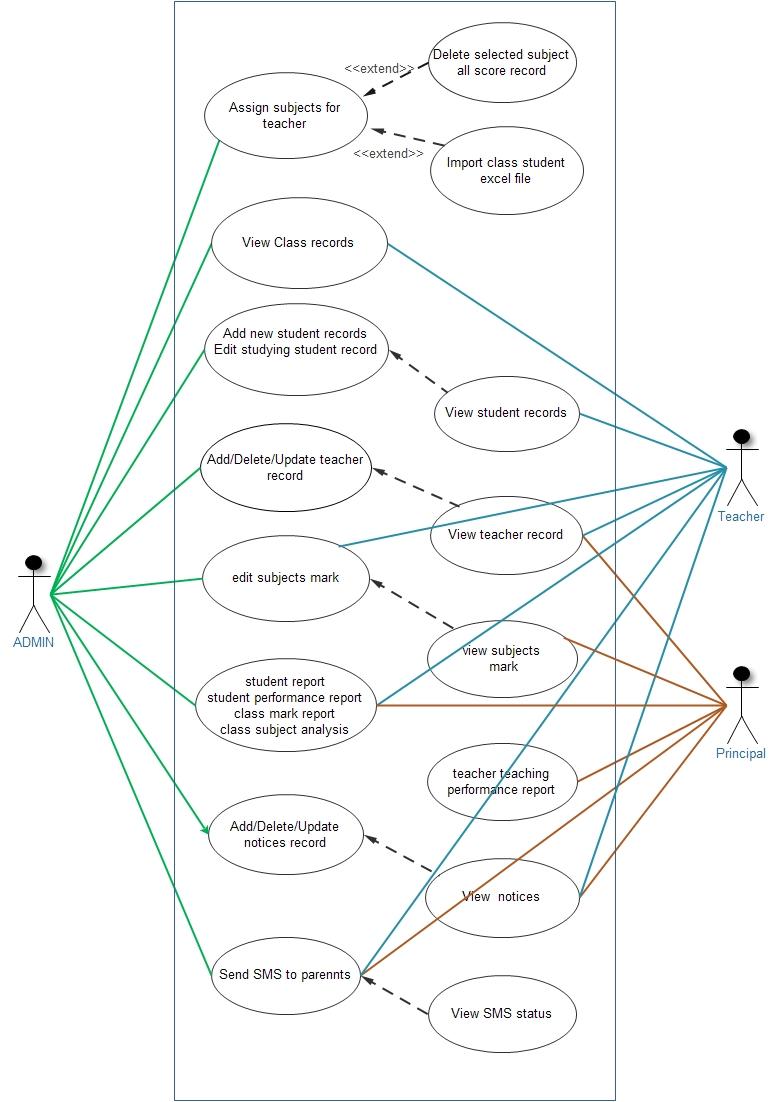
Student user can access after login process the following function as shown in figure 3.
- View school notice and reply if needed
- Flipped classroom for Liberal Studies
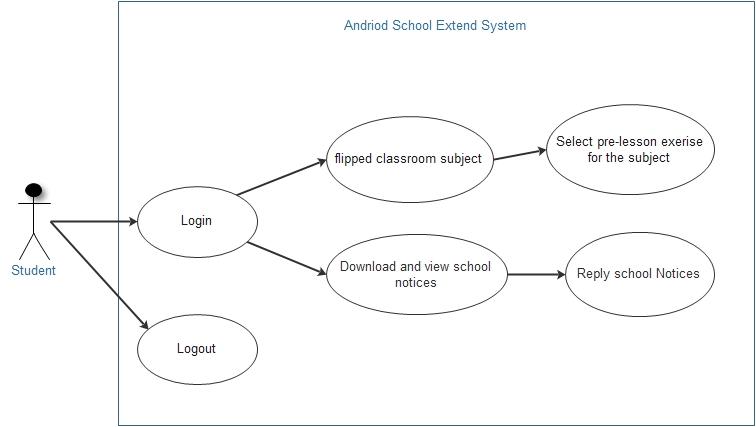
Sequence Diagram
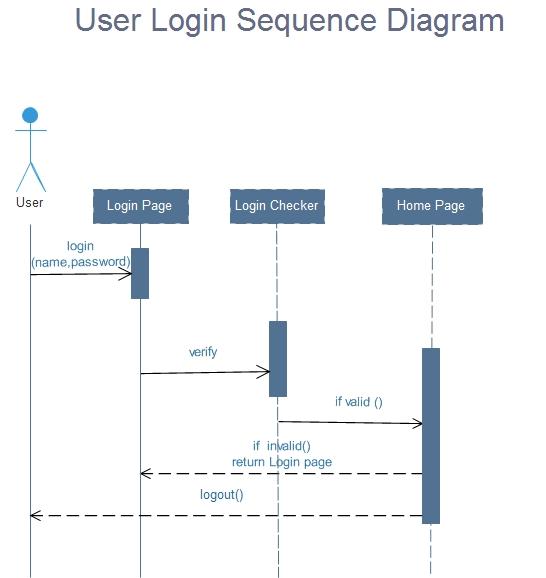
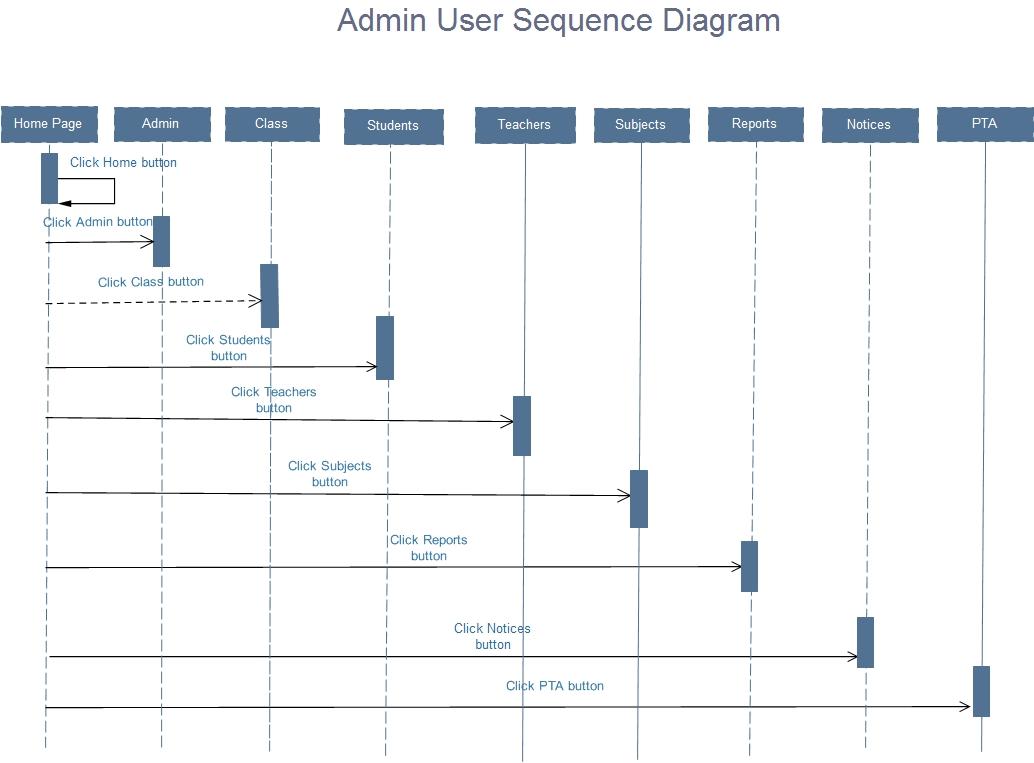
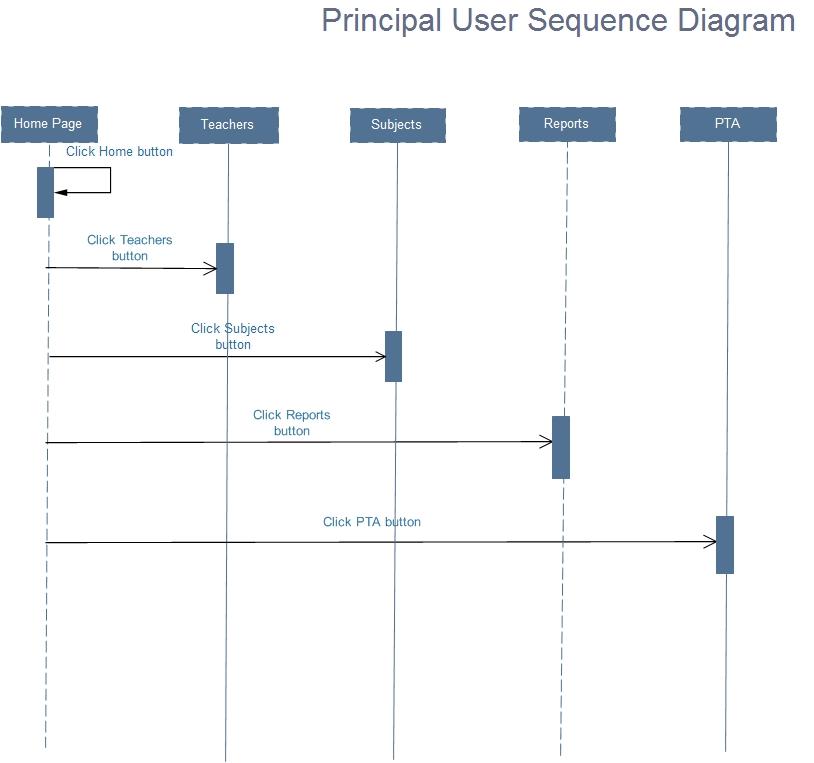
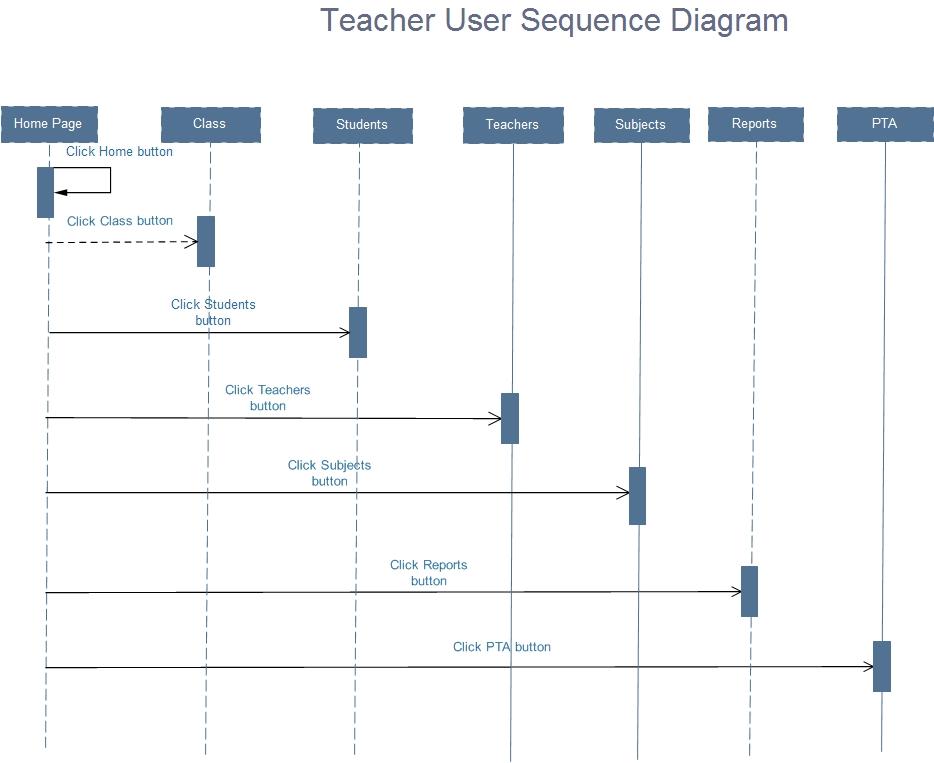
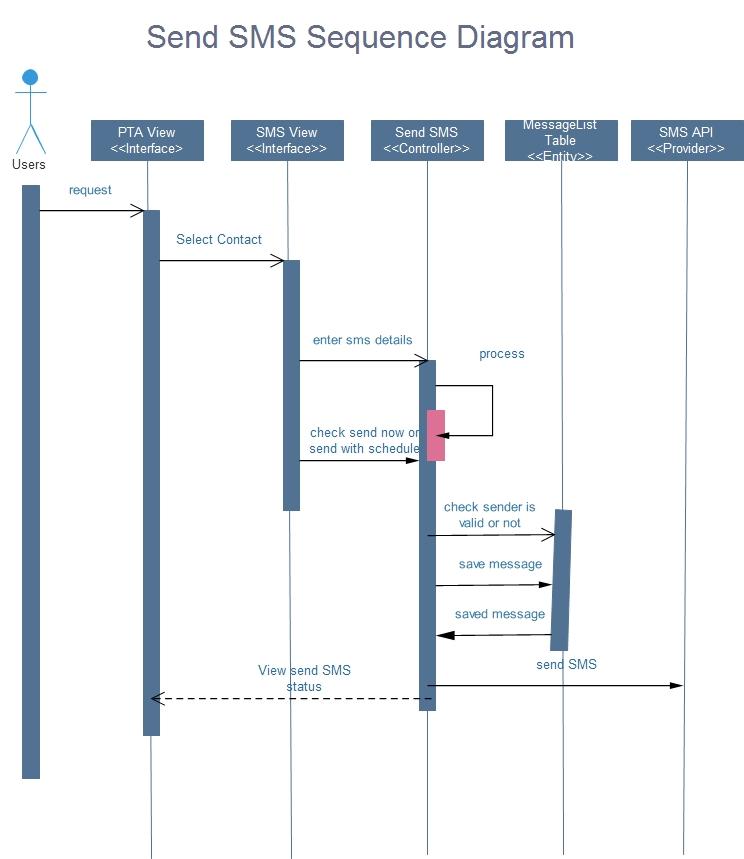
Activity Diagram
Admin User Activity

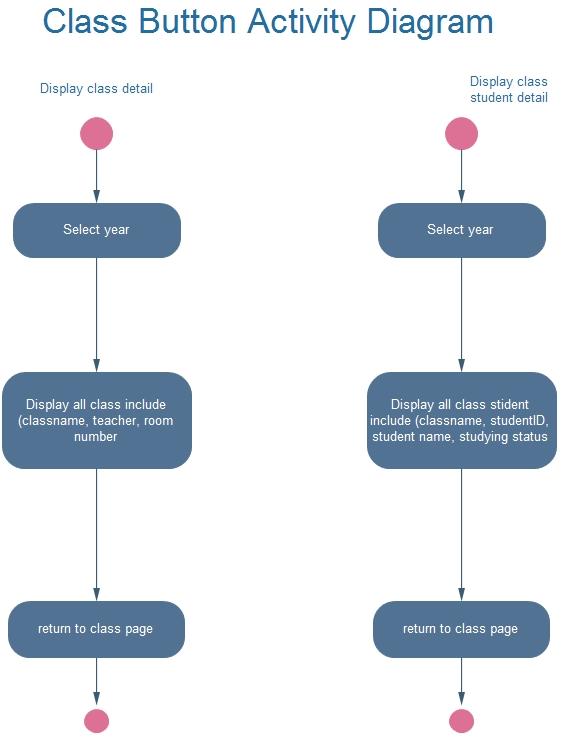
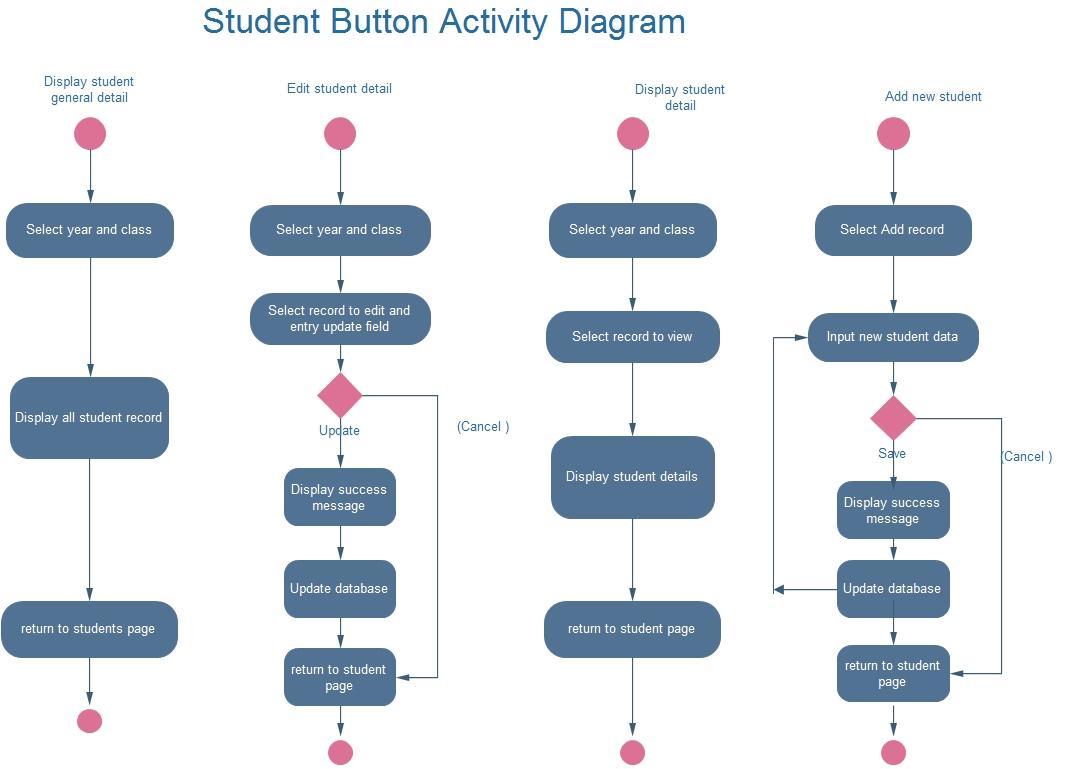
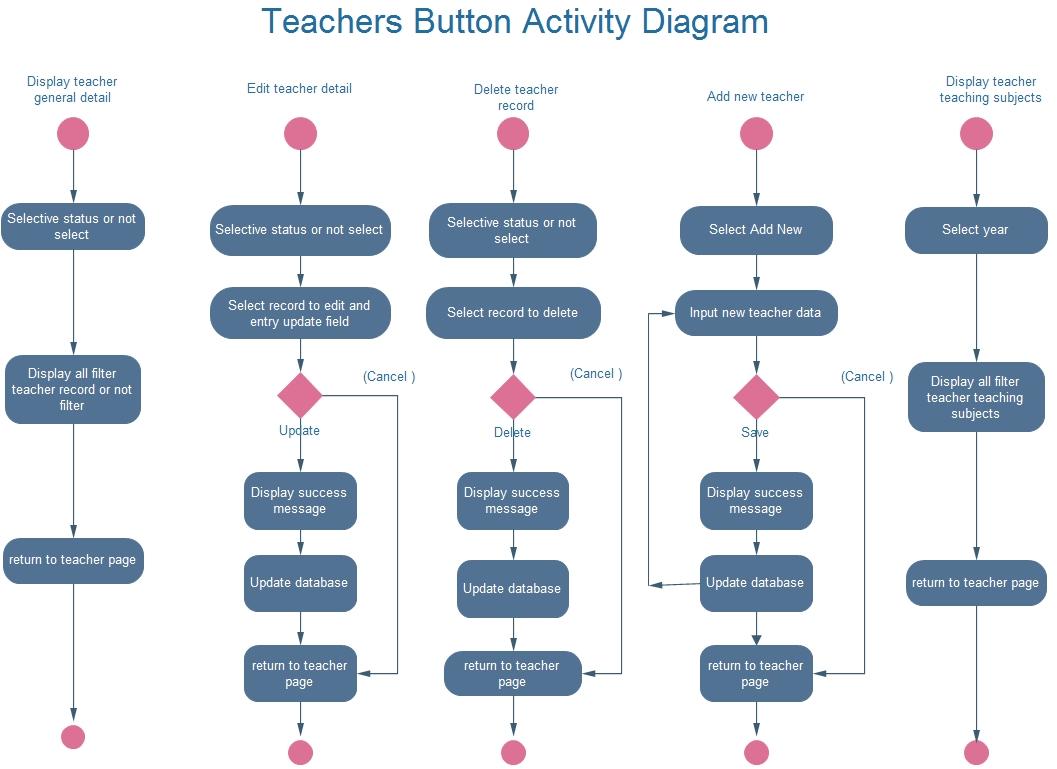
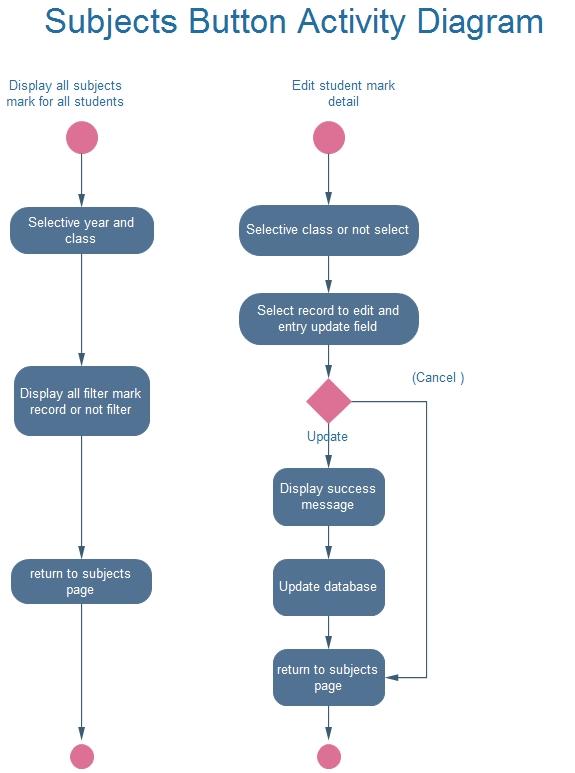
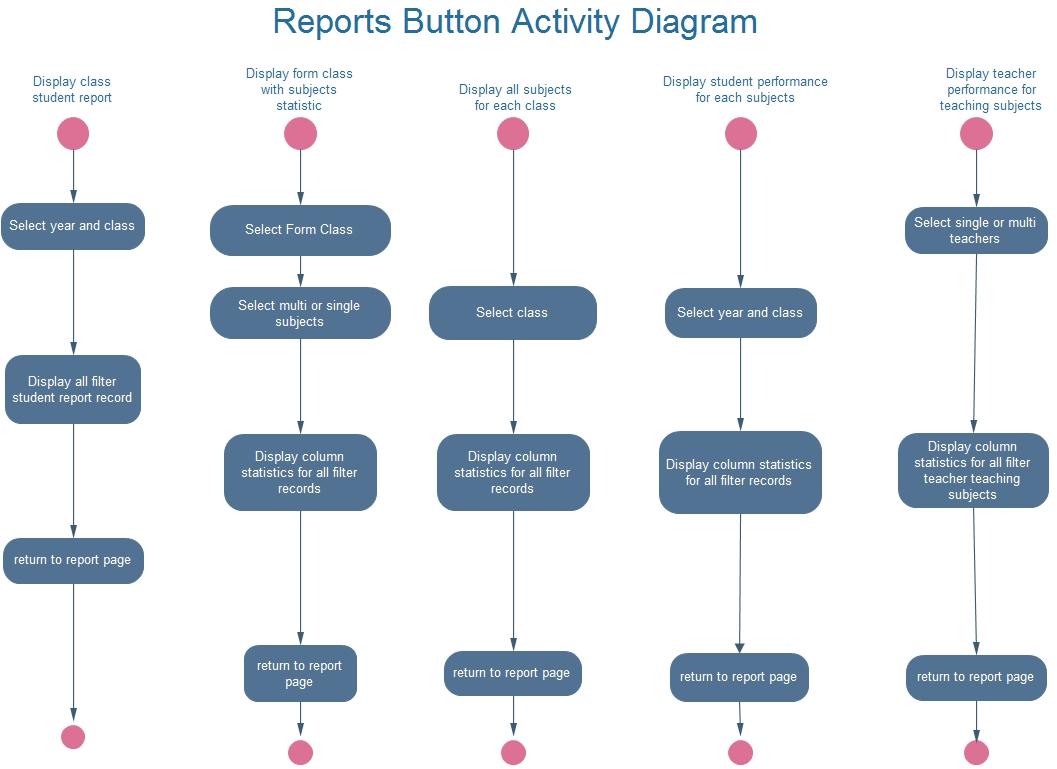
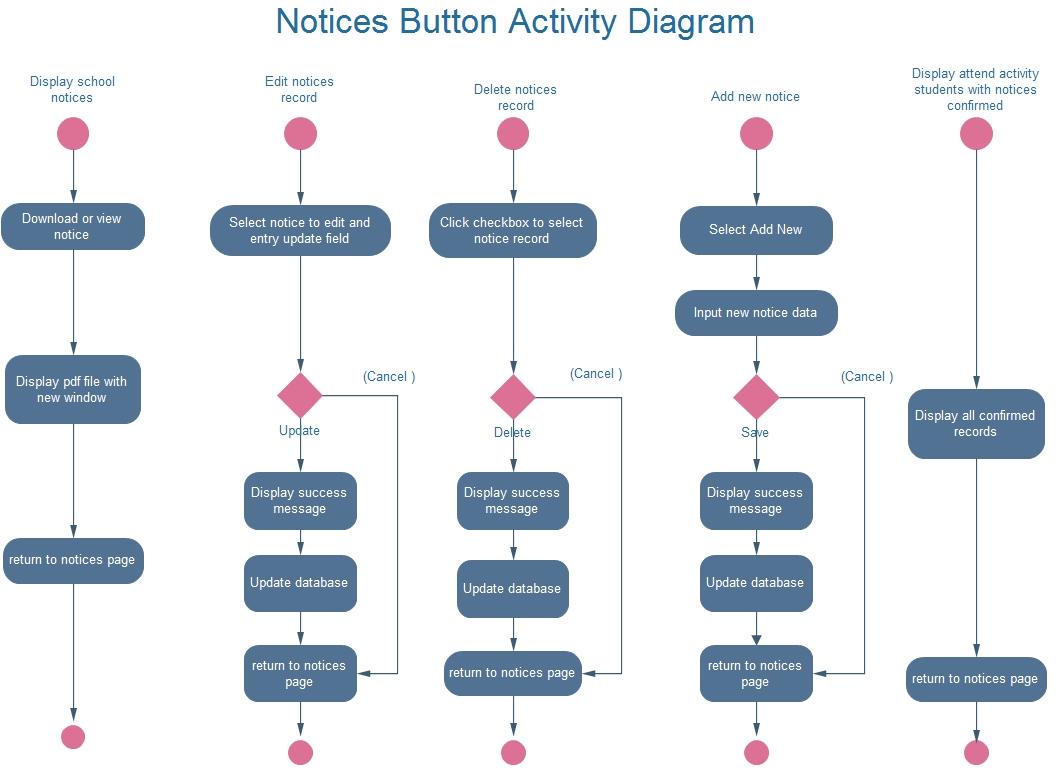

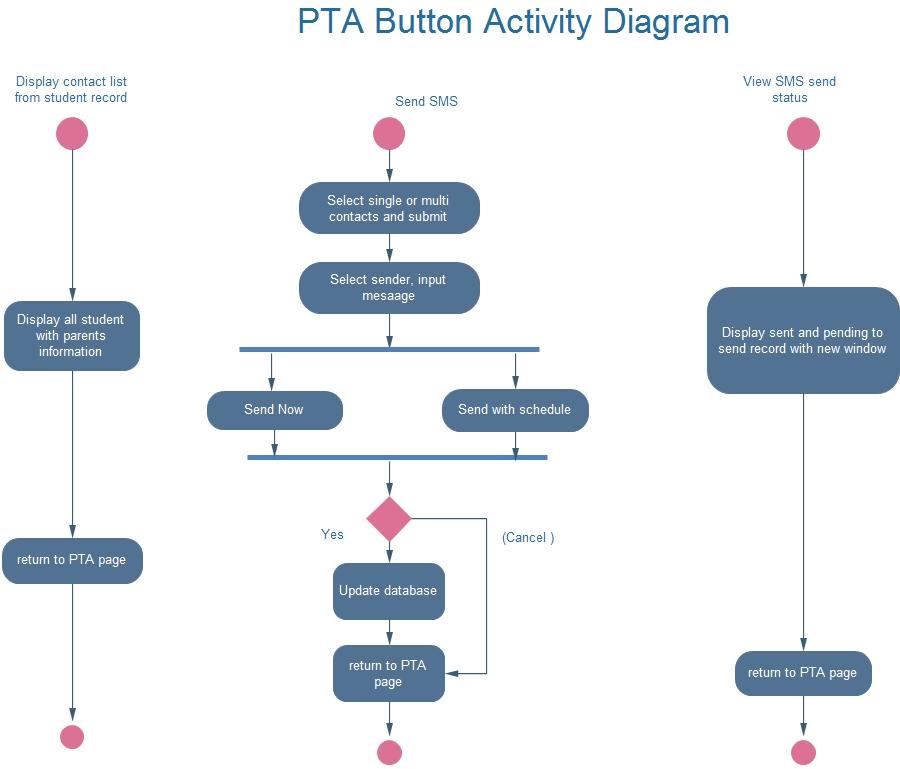
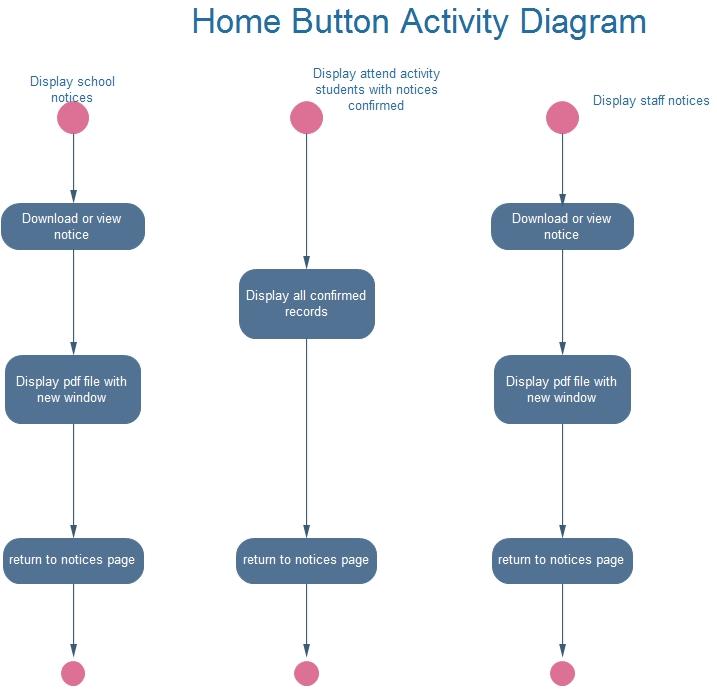
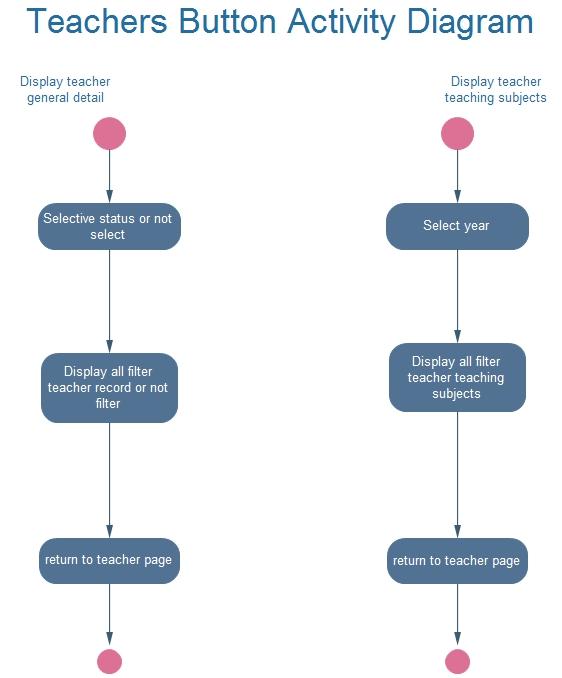
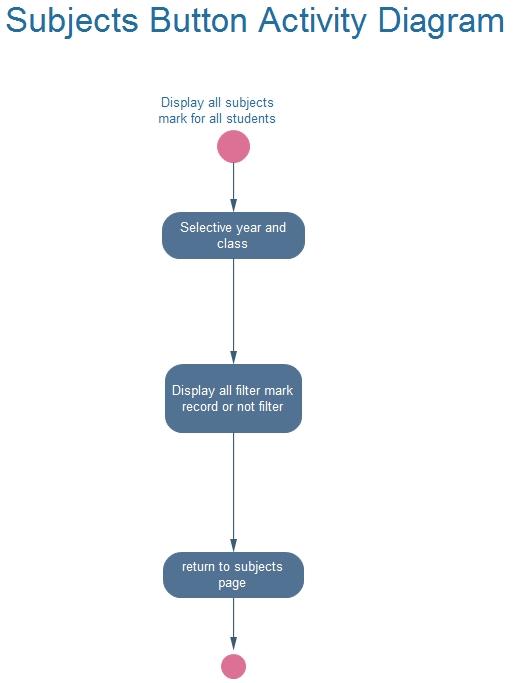
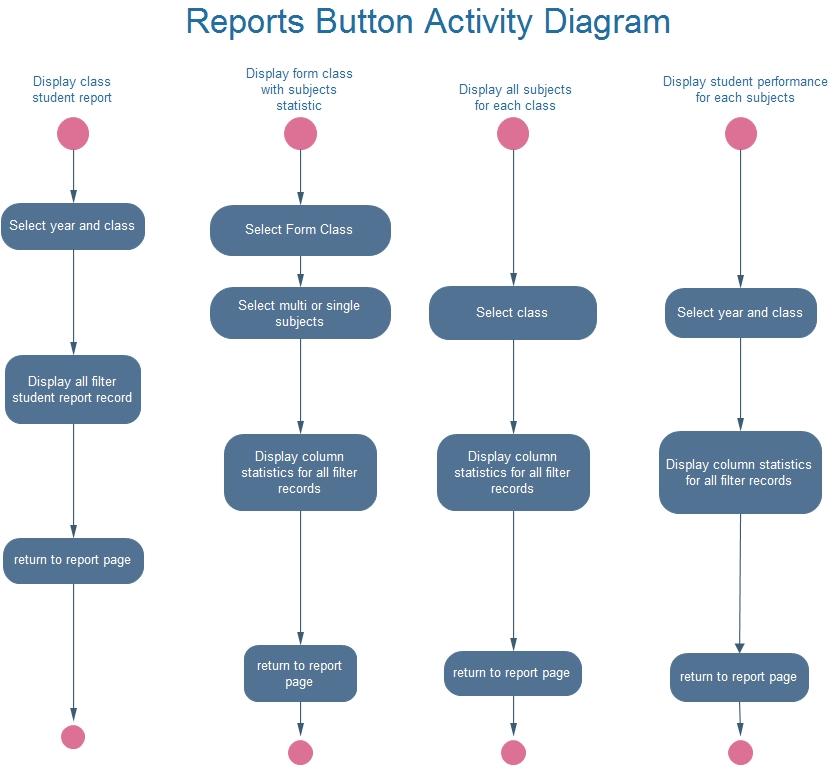

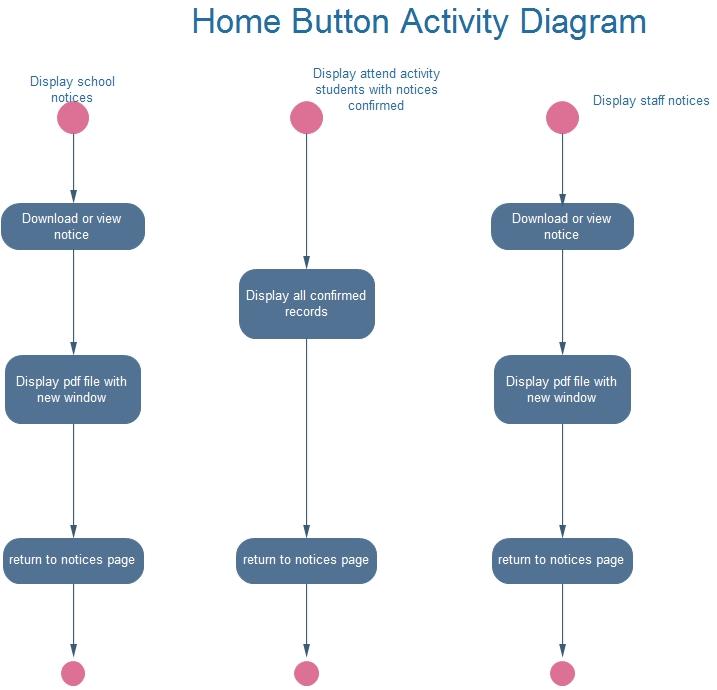
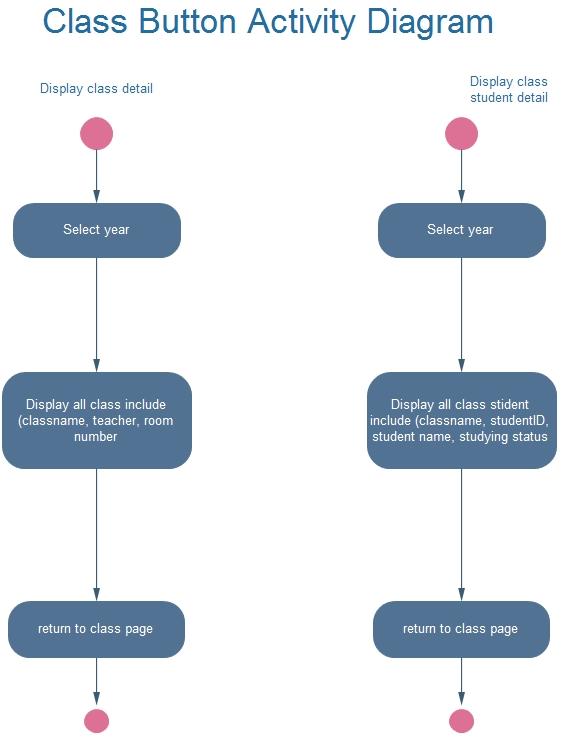
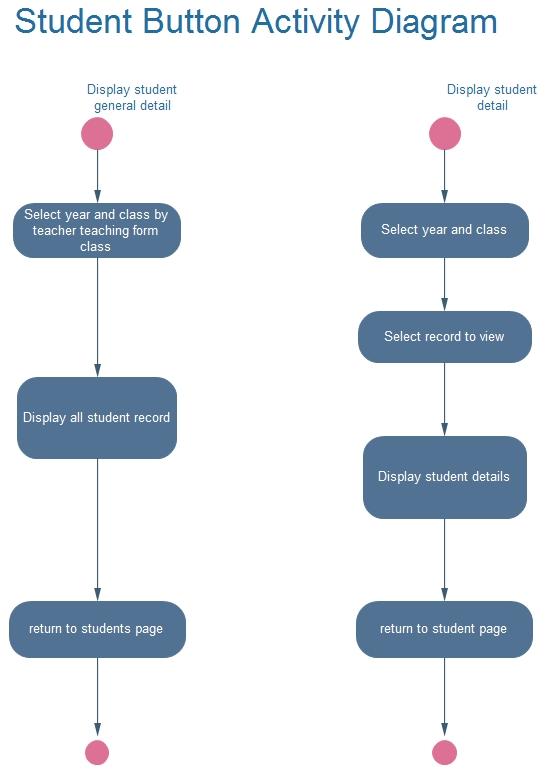

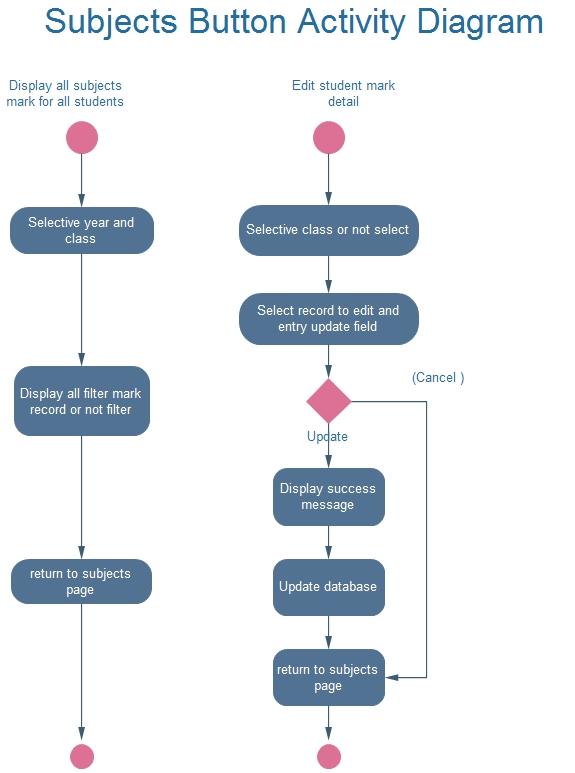

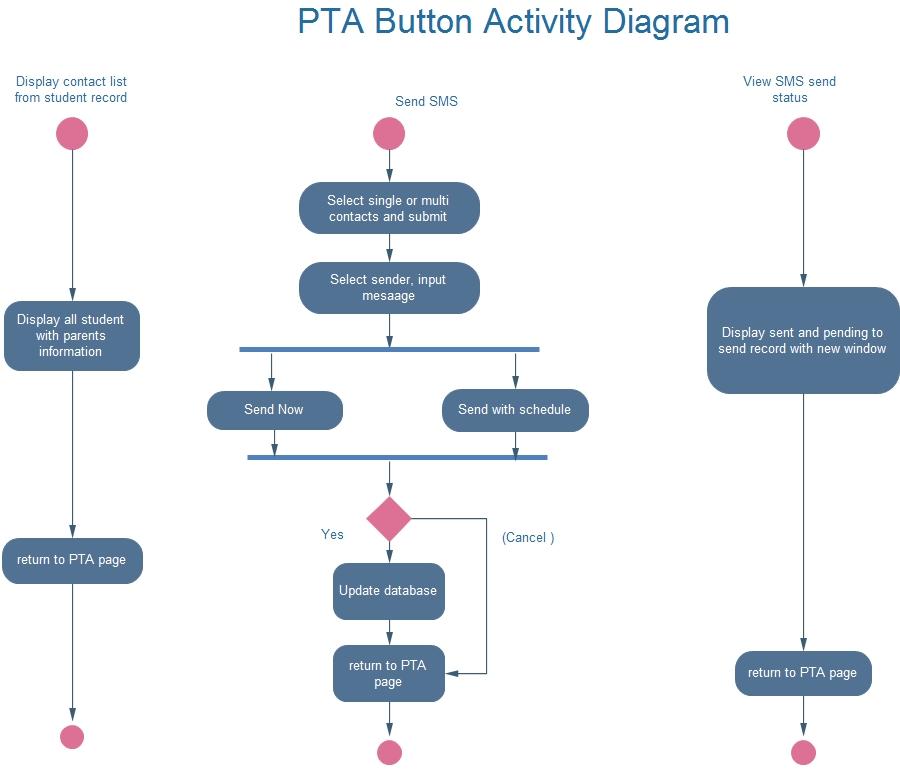

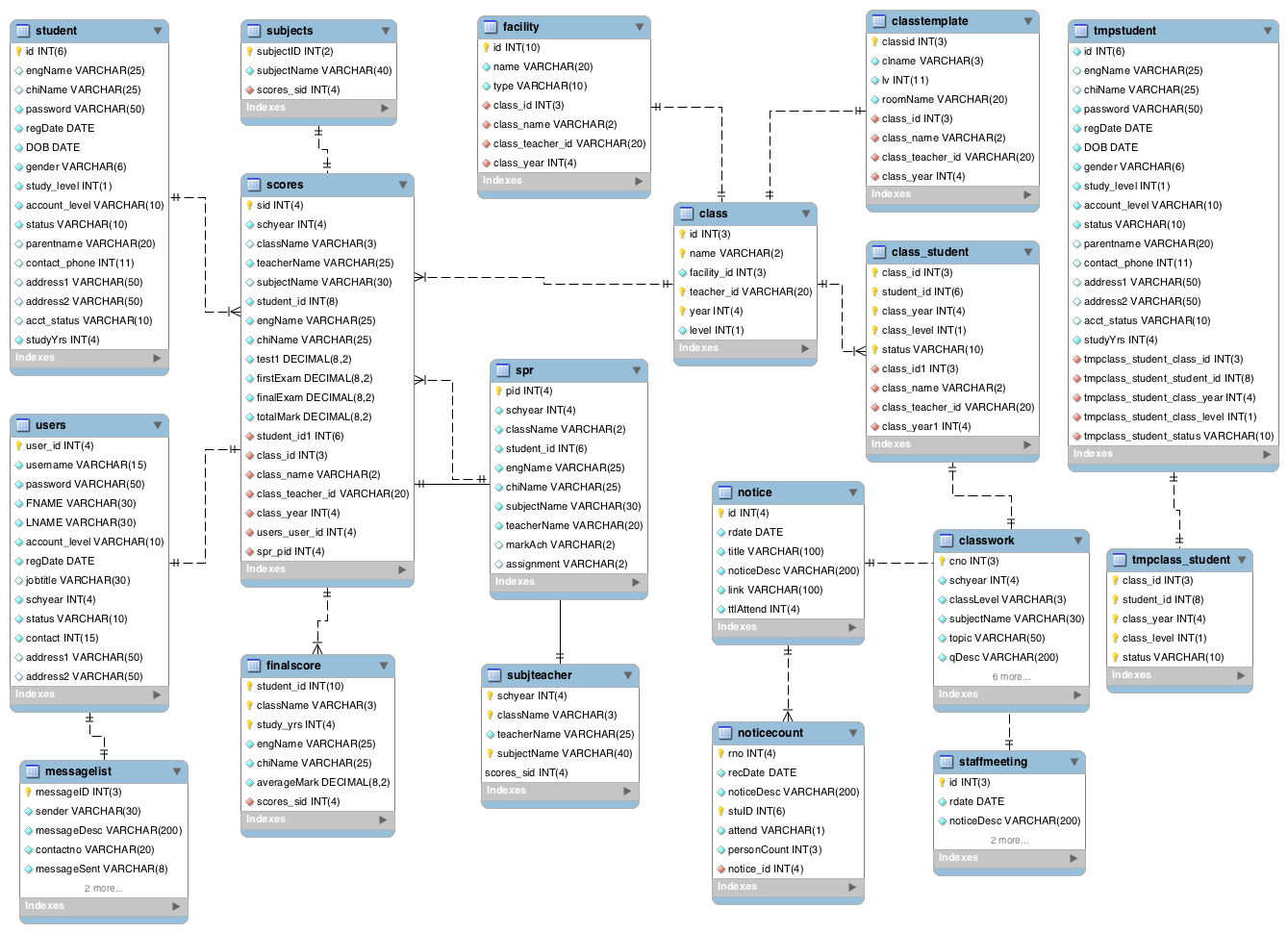
Database Schema




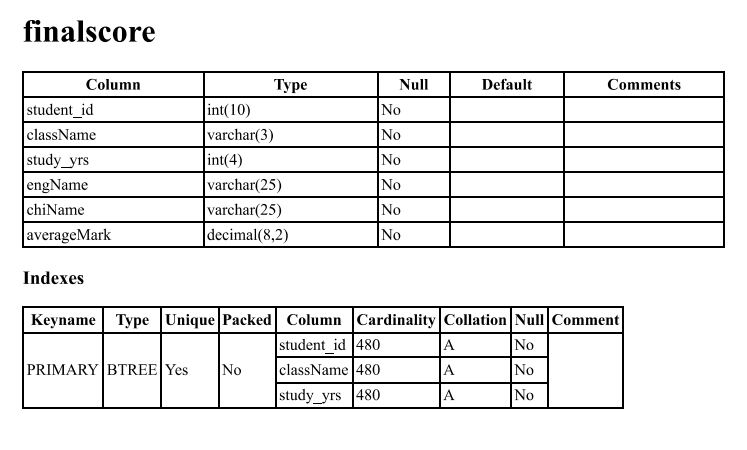
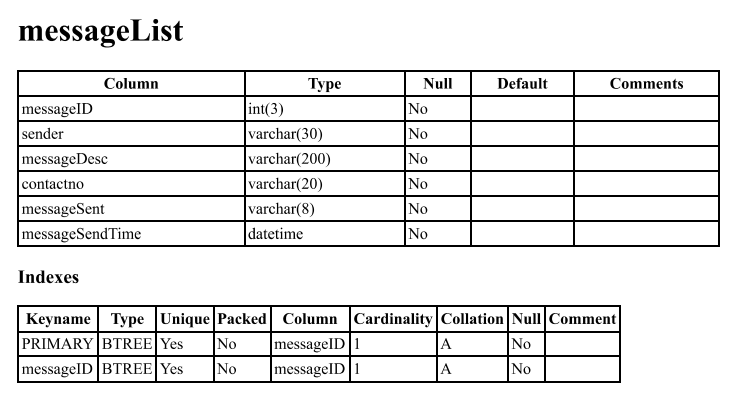
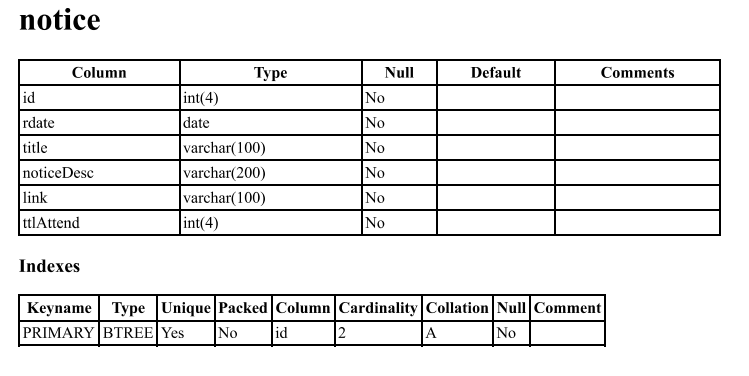
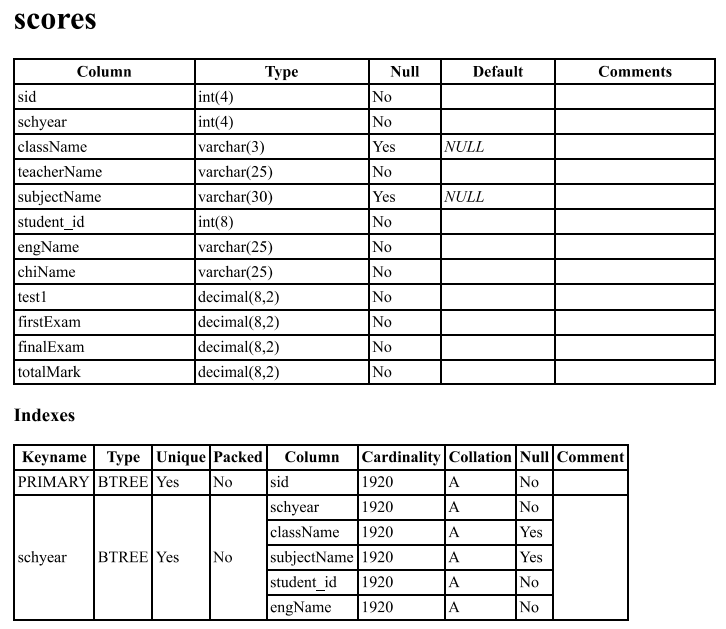
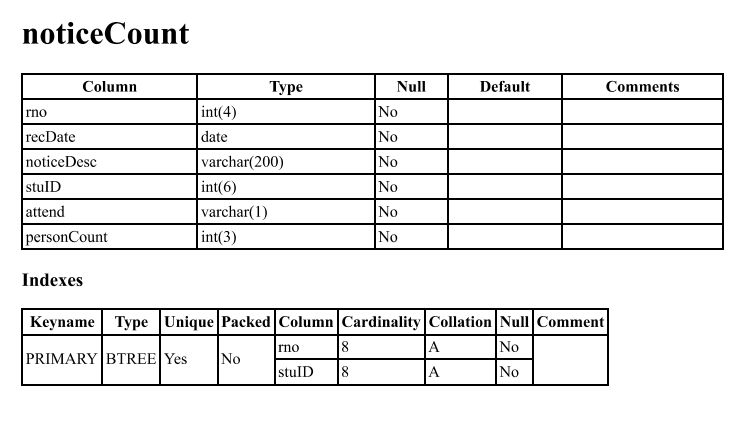
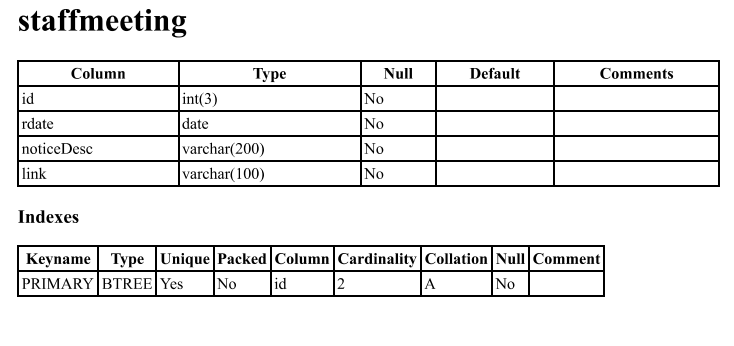
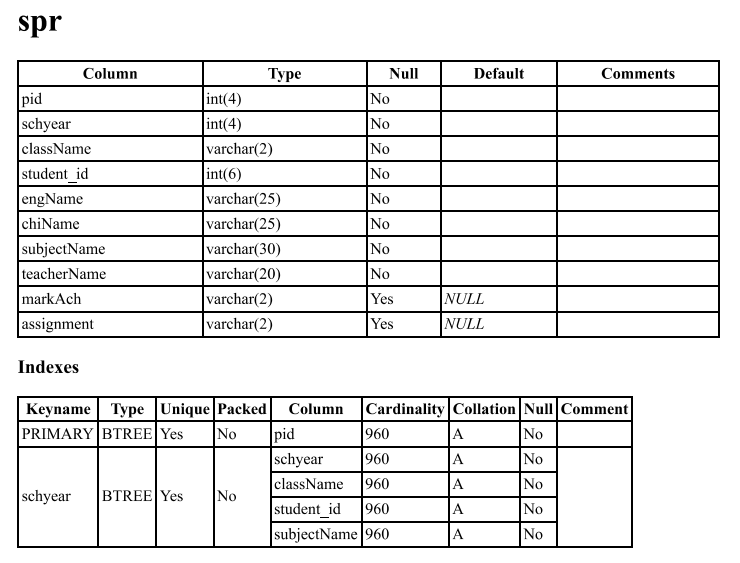
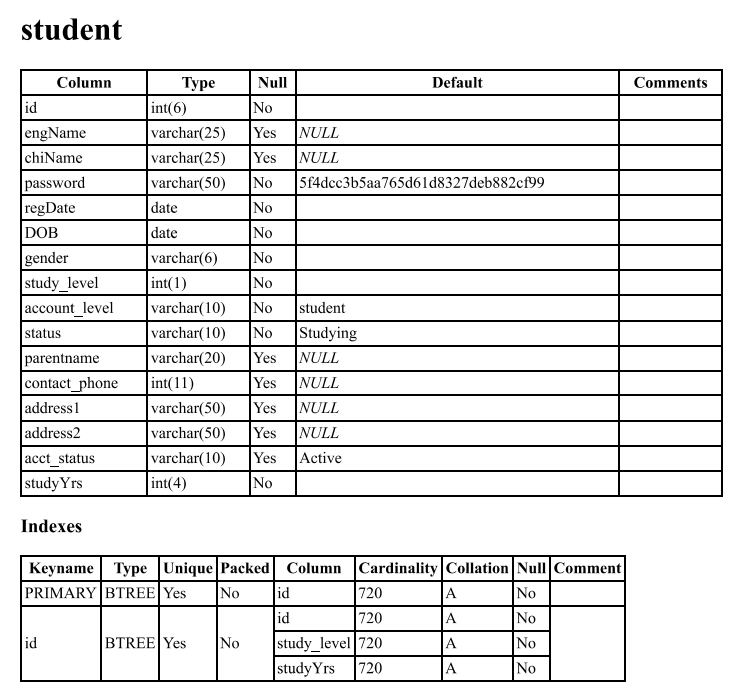
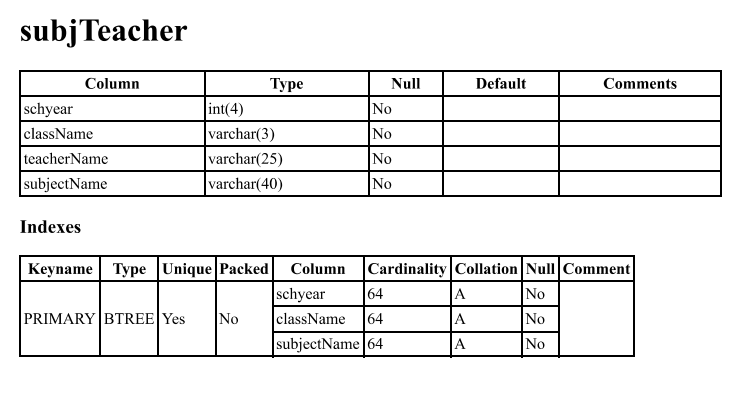
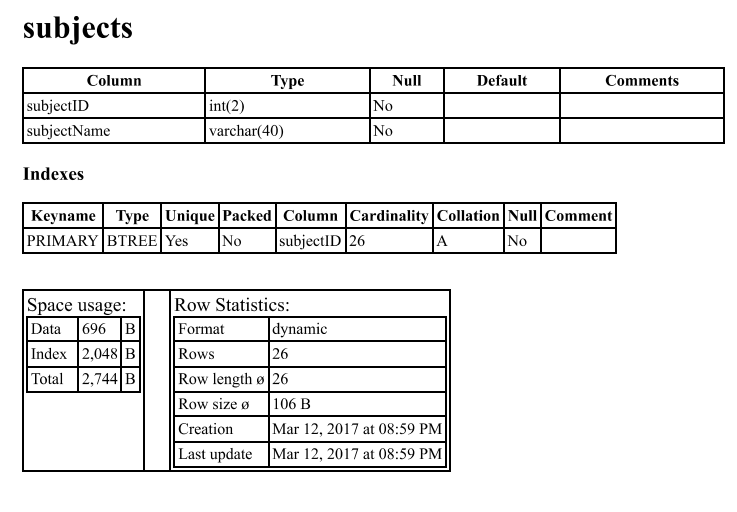
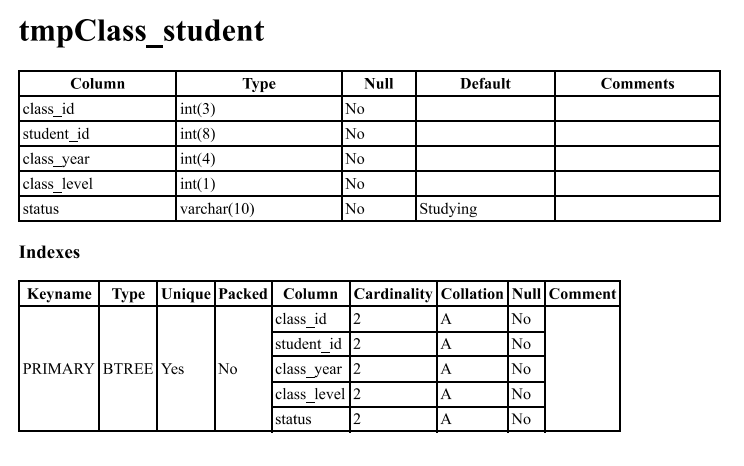
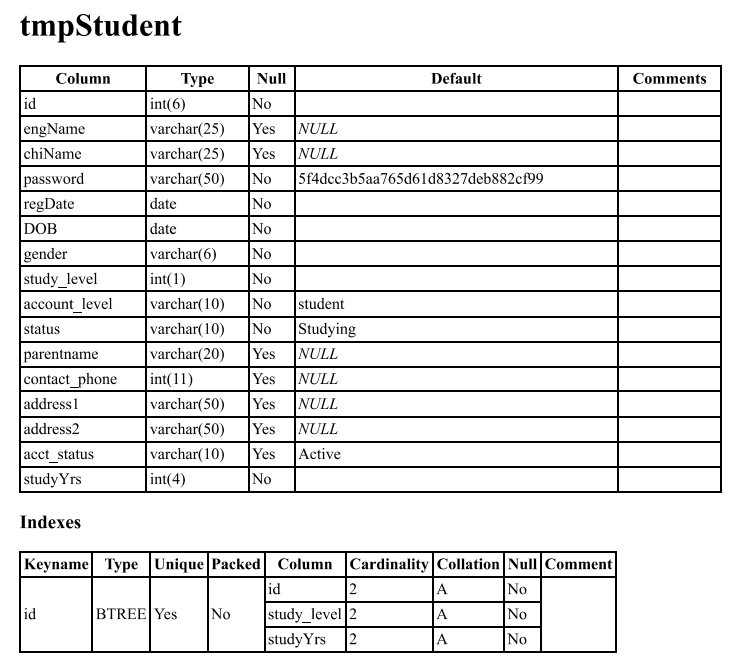
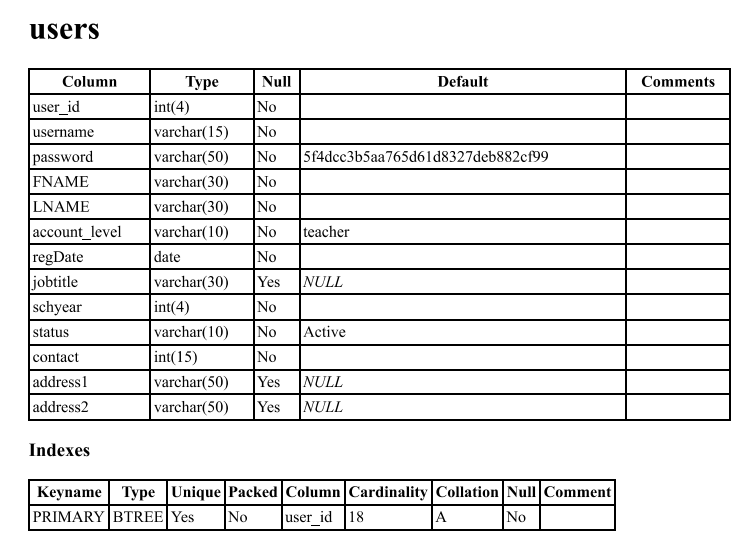
Conclusion and Future Enhancements
There is a huge need for KS Secondary School to have a web-based school management system. Web-based school management systems will assist the teachers, students, and other stakeholders at the school set-up to retrieve information that benefits the school. There are a number of web-based that can be used for school management. They both have their advantages and disadvantages. This paper focused on coming up with one that will counter the challenges that are being experienced.
Database Oasis will aid KS Secondary School as it has improvements regarding data information communication and easy monitoring of the school by parents, teachers, and other school stakeholders. The development of this web-based school management will benefit the students as they will be able to get the correct data within a short period and in the format that they require it. This will also be the same case in teachers and the involved stakeholders in the school that may need any data.
There was a lot of consideration that was looked into before the development of the database Oasis was developed for the web-based school management. Database Oasis is best because it can easily give the required data in the needed format. Future enhancements of the database oasis entail giving room for updates. This will help improve the operations of the web for KS Secondary School by conforming to the changes in the school.
System Evaluation
The students and the parents have used the system by accessing the school notice board and posted some replies. The students also manipulated the study subjects, including video clips; it was found that 70% of the students were satisfied, but 20% reported dissatisfaction, and 10% did not use the system.
The parents, however, reported the highest level of satisfaction with the system at 80%. Nevertheless, 10% were not satisfied, and another 10% did not use the system for unspecified reasons. The reason for satisfaction was mostly easy to use, while some students reported access to academic materials as a significant reason for satisfaction. The students who were not satisfied had issues with low technological know-how.
Among the teachers, 70% were satisfied, and again ease of use was cited as the major reason. Those who were dissatisfied with 20% had issues with the speed of the operating system. The school management, including the principal, was happy with the system. The reason given was that they were able to access data easily and can process the same in a short time.
The implementation of the project can be viewed as a success. The project implementers, however, need to address the issues raised by those who were not satisfied.
References
N. Chaudhry et al., Stream Data Management. New York, NY: Springer Science, 2005.
S. Aduwa-Ogiegbaen and S. Iyamu, “Using information and communication technology in secondary schools in Nigeria: Problems and prospects,” Ed. Tech. & Soc., vol. 8, no. 1, pp. 104-112. 2005.
J. Blazewicz et al., Handbook on Data Management in Information Systems. Heidelberg, Berlin: Springer Berlin Heidelberg, 2003.
G. Doty et al., The AARP Guide to Internet Resources Related to Aging. New York, NY: American Association of Retired Persons, 1996.
E. Ferrari, Access Control in Data Management Systems. New York, NY: Morgan and Claypool Publishers, 2010.
A. Glang et al., “The effectiveness of a web-based resource in improving post-concussion management in high schools,” J. Adolesc Health, vol. 56, no. 1, pp. 91-97. 2014.
E. Gonzalez, Connecting the Nation: Classrooms, Libraries, and Health Care Organizations in the Information Age. New York, NY: DANE Publishing, 2004.
Q. Jiao and L. Liu, Internet Resources and Services for International Finance and Investment. Phoenix: Greenwood, 2001.
C. Joseph et al., “Evaluation of a web-based asthma management intervention program for urban teenagers: Reaching the hard to reach,” J. Adolesc. Health, vol. 52, no. 4, pp. 419-426. 2013.
J. Keleher, Use of Data Management Systems and Data-Driven Decision Making among school-Level Administrators and Educators. New York, NY: ProQuest Information and Learning Company, 2007.
B. Kurdi et al., “Introducing the Open Affective Standardized Image Set (OASIS),” Behav. Res. Methods, pp. 1-15. 2016.
T. Leibfried et al., Data Management Systems (DMS) Complex Data Types Study. Houston, Tex.: Research Institute for Computing and Information Systems, 1992.
A. Messina et al., “The database-is-the-service pattern for microservice architectures,” in International Conference on Information Technology in Bio-and Medical Informatics, New York: Springer International Publishing, 2016, pp. 223-233.
E. Miller, The Internet Resource Directory for K-12 Teachers and Librarians. New York, NY: Free Press, 2001.
J. Cash et al., Building the Information-Age Organization: Structure, Control, and Information Technologies, 3rd ed. Mason, OH: Richard D Irwin, 1994.
S. Papantoniou, et al., “Building optimization and control algorithms implemented in existing BEMS using a web-based energy management and control system,” Energy and Buildings, vol. 98, pp. 45-55. 2015.
W. Scheeren, Technology for the School Librarian: Theory and Practice. Santa Barbara, CA: Libraries Unlimited, 2010.
G. Levermore, Building Energy Management Systems: An Application to Heating, Natural Ventilation, Lighting, and Occupant Satisfaction. London: Routledge, 2000.
U. Hansmann et al., Smart Card Application Development Using Java, 2nd ed. London: Springer, 2002.
K. Daly, Financial Management Systems: Experience with Prior Migration and Modernization Efforts Provides Lessons Learned for New Approach. London: GAO, 2010.
A. Beloglazov et al., “Energy-aware resource allocation heuristics for efficient management of data centers for cloud computing,” Fut. Gen. Comp. Sys., vol. 28, no. 5, pp. 755-768. 2011.
D. Rochwerger et al., “The reservoir model and architecture for open federated cloud computing,” IBM J. of Res. and Dev., vol. 53, no. 4, pp. 4-1. 2009.
A. Fayez, Information Systems Applications in the Arab Education Sector. Hershey: GI Global, 2012.
G. Magyar et al., Advances in Information Systems Development: New Methods and Practice for the Networked Society. New York, NY: Springer Science & Business Media, 2007.
O. Mette and E. Boxenbaum, “Bottom-of-the-pyramid: Organizational barriers to implementation,” Cal. Mgt. Rev., vol. 51, no. 4, pp. 100-125. 2009.
A. Tatnall et al., Information Technology and Educational Management in the Knowledge Society. Berlin: Springer, 2006.
A. Visscher et al., Information Technology in Educational Management. Berlin: Springer Science & Business Media, 2013.